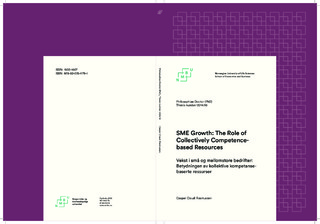| dc.contributor.advisor | Lunnan, Anders | |
| dc.contributor.advisor | Korhonen-Sande, Silja | |
| dc.contributor.author | Rasmussen, Casper Claudi | |
| dc.date.accessioned | 2017-01-30T14:36:03Z | |
| dc.date.available | 2017-01-30T14:36:03Z | |
| dc.date.issued | 2014 | |
| dc.identifier.isbn | 978-82-575-1179-1 | |
| dc.identifier.issn | 1503-1667 | |
| dc.identifier.uri | http://hdl.handle.net/11250/2428949 | |
| dc.description.abstract | High-growth firms contribute disproportionately to job and value creation. Previous research on high-growth firms has shown that high-growth firms are characterized by innovative qualities, have important spillover effects, and are, in general, smaller and younger than other firms. To experience growth, a firm must have a competitive advantage. By applying a resource-based framework, this thesis analyzes high-growth firms from a management perspective and aims to understand how small and medium-sized enterprises configure and exploit their collectively competence-based resources to achieve high growth.
In so doing, this thesis contributes to the literature in three ways: first by examining the direct effects of collectively competence-based resources on company growth; second, by applying mediation and moderation effects to examine how high-growth firms exploit and configure their resources; and, third, by applying different growth indicators and contributing to the ongoing discussion regarding problems with the measurement and conceptualization of firm growth.
Paper I was based on a questionnaire for high-growth firms in Norway and shows that innovativeness is a factor in whether firms become high-growth firms and that innovativeness acts as a full mediator for learning and a creative climate. Paper II was based on a questionnaire for firewood producers in Norway and shows that customer orientation and innovativeness are important drivers in the growth of microfirms. Papers III and IV were based on a questionnaire administered to high-growth firms in Norway. Paper III shows that board composition is likely to differ between high-growth firms and other types of firms. Paper IV shows that the mode of growth affects the impact of entrepreneurial orientation on growth. | nb_NO |
| dc.language.iso | eng | nb_NO |
| dc.publisher | Norwegian University of Life Sciences, Ås | nb_NO |
| dc.relation.ispartofseries | PhD Thesis;2014:10 | |
| dc.rights | Attribution-NonCommercial-NoDerivatives 4.0 Internasjonal | * |
| dc.rights.uri | http://creativecommons.org/licenses/by-nc-nd/4.0/deed.no | * |
| dc.title | SME growth : the role of collectively competence-based resources | nb_NO |
| dc.title.alternative | Vekst i små og mellomstore bedrifter : betydningen av kollektive kompetanse-baserte ressurser | nb_NO |
| dc.type | Doctoral thesis | nb_NO |
| dc.subject.nsi | VDP::Samfunnsvitenskap: 200::Økonomi: 210::Bedriftsøkonomi: 213 | nb_NO |
| dc.source.pagenumber | 1 b. (fl. pag) | nb_NO |

